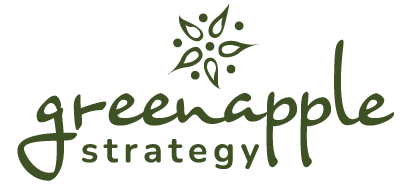It’s easy to overlook email when shiny new marketing tools pop up every month. But here’s the truth: email still works. In fact, B2B email marketing generates an average ROI of $36 for every $1 spent. That’s a number worth paying attention to.
That said, what worked a year ago might not work today. Inbox competition is fierce. Platforms like Google and Yahoo are incorporating authentication updates to create a more secure and trustworthy email ecosystem. Everyone’s fighting for attention, and your audience is getting savvier. They’re skimming faster, ignoring the generic, and only clicking when something feels truly relevant. That’s why strategy is essential, and that’s where Green Apple Strategy excels.
The Green Apple team is constantly helping clients rethink and refresh their email approach. To give you the inside scoop, we asked Amanda Monroe, one of our email strategists in the Green Apple Orchard, to share what’s working, what’s not, and what you might want to try next.
Email Marketing Tactics That Aren’t Working
Here’s a quick audit of the email habits you might want to rethink, plus smarter ways to reach your audience.
1. Don’t “Just send another email!”
We get it: email is fast and easy. But mass-blasting without a strategy can hurt your sender reputation and frustrate your audience. If your open rates are tanking or your list is shrinking, it might be time for a change.
Instead: Clean your list regularly. Run a reengagement campaign and remove subscribers who never open your emails. Focus on the contacts who do engage and create more content for them. A smaller, more interested list is better than a big one that ghosts you.
2. “Hi [First name]” is not personalization.
Sure, it’s technically personalized. But consumers are past the point of being impressed by a mail merge. If your content doesn’t feel relevant beyond a name, it’ll likely get skipped.
Instead: Start to think about personalization based on behavior, interests, or location. Try different subject lines to increase engagement. You can even reference a recent download or a service they clicked on. The goal is to make readers feel like the email is actually for them, not just their first name.
3. Batch-and-blast everything to everyone.
This one’s tempting, especially when you’re short on time. But sending every email to your full list dilutes your message and can lower your engagement across the board.
Instead: Segment your audience. Send fewer emails tailored to their interests or stage in the customer journey. You’ll get better open and click rates and build stronger connections with each group.
New Email Tactics Worth Trying
When it comes to optimizing your marketing, it’s important to recognize that not everything needs a total overhaul. Sometimes, it’s about adding smart, strategic upgrades. Here are five trends we’re using right now that are actually moving the needle for our clients:
1. Send intent-based emails.
Let your audience’s behavior lead the way. If someone visits your pricing page twice in one week but never reaches out, that’s your cue. Trigger an email that says something like, “Need help deciding?” and share a helpful case study or offer a quick consult. This feels personalized and timely—because it is.
Test It: Set up a basic behavior-based trigger in your email platform using a key webpage (like your pricing or contact page) and link it to a single follow-up email.
2. Try plain-text, human emails.
Polished, branded emails have their place. But lately, plain-text emails that look and feel like a real message from a real person? They’re winning. Try sending a short note from your founder or sales team, something conversational, warm, and focused on starting a dialogue. It’s a simple way to sound more human and drive more replies.
Test It: Write a three-sentence email from your founder to recent leads with one simple CTA like, “Want to chat?” and see how the response rate compares to a branded campaign.
3. Create reengagement journeys.
You probably already have a list of past customers or inactive subscribers. Why not check in? A thoughtful reengagement series with phrasing like “We miss you!” or “Here’s what’s new!” can bring them back into the fold. For most brands, it’s often easier (and cheaper) to reconnect with former customers than to start from scratch.
Test It: Export a segment of inactive contacts and send them a one-time check-in email with a warm update and simple ask: “Still want to hear from us?”
4. Use lead gen automations.
Want more leads? Offer something useful. Create a guide, checklist, or quiz, something that helps your audience solve a real problem. Then be intentional about building trust and nurturing the relationship with a compelling email newsletter strategy or automation campaign. Focus on being helpful before being salesy. Your future customers will thank you.
Test It: Create a basic PDF guide or “top tips” checklist related to your industry, and gate it with a form that adds all new contacts to a short welcome email series.
5. Pursue consumer-led content and segmentation.
Guessing what your subscribers care about? It’s risky. Instead, give them choices. Use a quick survey, a preference center, or even a fun quiz to let people self-select the content they receive. This leads to fewer unsubscribes and better engagement—because you’re building and nurturing your email subscriber list by offering content they want to see.
Test It: Add a one-question poll to your next email: “What do you want to hear more about?” Use the responses to inform your next campaign.
Email Is Evolving
Email is one of the most valuable tools in your marketing toolkit, but only if it’s evolving with your audience. A thoughtful strategy, timely insights, and a little experimentation can go a long way in helping you drive better results (without sending more emails).
Need a fresh perspective? At Green Apple Strategy, we help small and mid-size businesses take a smarter, more strategic approach to every part of marketing. Whether you’re looking for a full-service marketing partner or just need help refreshing your marketing strategy, we’re here to help. Check out our strategic planning services or contact our team for a quick consultation.


